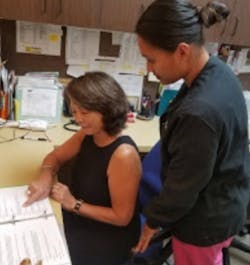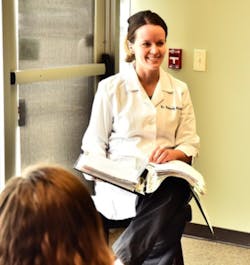Is your front desk losing patients and patience with safety?
Gayle Chang, RDH, seated, of Dentaworks Hawaii, talks to the practice’s safety officer, Marilyn DelaCruz.
A few years ago I offered to do a complimentary safety consultation for the dentist my mom visited. As a result, we discovered the sterilizer had not been tested in six months. I was concerned about the lack of testing, but my subsequent repeated phone calls to the practice to see if they had solved the problem were never returned.
Fast forward to my recent trip to see my mother in Hawaii, when she confessed she had not been to the dentist in a few years. A few years! Because we did not hear back from her previous dentist’s office, she was afraid of what else might be going on behind the scenes related to safety. She decided she would rather not go to the dentist, any dentist, anywhere, ever again.
Knowing my mother’s flair for drama, I took this information in stride while I sat in her kitchen noshing on a sweet papaya. Though it was the first day of my visit, I resolved to immediately find a practice that treated every patient like family. I began to make the first of many calls.
Practice number one had one of the highest Yelp reviews, so I made an appointment and anticipated I’d get the safety answers I wanted. I know, I know . . . we live in an era where offices can purchase five-star reviews or bribe people with toothbrushes for a positive review. But I figured this was a good place to start. It took three phone calls to reach someone who would even talk to me about infection control, and on the final call I was told the new manager had decided not to share any information with me. I did not make an appointment.
Here’s the conversation that transpired between me and practice number two. “Hello, my name is Karen and I have a few safety questions. May I speak with the infection control or OSHA coordinator?”
“Um, I’ll have to check to see if we have one.”
I was put on hold. Then a hurried voice said, “This is Donna, who is this?”
I repeated myself, “Hi, my name is Karen, and I have a few questions. May I speak with someone who can discuss safety with me? I’m calling on behalf of my mother. We’re looking for a new practice.”
“OKaaaay . . .” followed by silence.
“So, I have some safety questions.”
“Safety?”
“Yes, please. I was wondering . . .”
She interrupted me, “What is your name and number? I’ll have to have someone call you back."
A week went by and I left a message for Donna, but received no return call. So much for practice number two.
I thought maybe the third time would be a charm. Here’s the call in its entirety accompanied by my internal commentary.
“Hello, my name is Karen. I’m calling on behalf of my mom. I have a few basic patient safety questions. May I speak with someone who can assist me?”
“I can help you.”
“Great! We’re looking for a new dental practice. Your website says you follow OSHA, CDC, and ADA guidelines. May I ask you about this?”
“OK.”
“How often do you test your sterilizer?”
“Monthly.”
“Are you sure?”
“Yes, I’m the one who runs the strips.”
“Did you know the CDC recommends weekly testing?”
“Is that a requirement?”
“Well, it’s best practice, the state board of dentistry enforces this, and you say you follow CDC.”
“Well, we know they’re sterile because there are these arrows that change color. I can show you when you come in.” Here was the first red flag.The educator in me wanted so badly to talk about what chemical indicators really tell us, but I had a few more questions. So I asked, “Would you be willing to test weekly?”
“I’ll have to talk to the doctor.” She sounded perturbed. There was a long pause.
”OK, what about annual OSHA and infection control training?”
“We alternate between the two each year and we listen to a speaker. Otherwise, we pop in the tape.”
“Did you realize OSHA is annual?”
I hear murmuring in the background, then she blurts out, “I mean we do both every year.” Riiiiiiight.
“Would you be willing to share your CE certificates with me?”
Another long pause as if she’s searching for the best answer, “Is that a requirement?”
“No, but . . .”
“Then, no,” she replied curtly. I thought, man, this is going downhill fast.
I continued, “Are your instruments packaged until the patient is seated?”
“Instruments are open and ready for the patient so we don’t waste anybody’s time. They are covered for patient safety.”
Before I get in the next word she cuts me off. “Who is this again?”
“I’m calling on behalf of a potential patient. My name is Karen. I never did get your name. May I please . . . ” The phone went dead.
Dr. Kimberly Michalak of Hayden Run Dentistry leads her staff in training.
Did you spot at least 20 areas for improvement in these scenarios? Here are the questions I started with:
• How often do you test the sterilizer?
• Will you share the most recent results?
• Does the practice participate in annual OSHA bloodborne pathogens and infection control education?
• Do you open instrument packets in front of the patient? (My mother insisted on this one.)
• May I tour your sterilization area?
The CDC document that I based some of my questions on is titled Summary of Infection Prevention Practices in Dental Settings: Basic Expectations for Safe Care. It’s the bare minimum, folks. I asked the hospital staff where I had my gallbladder removed safety questions. Why wouldn’t I ask safety questions of my dental practice?
The responses that I received when I placed phone calls the rest of the morning were all over the place. The business side of me felt bad because this was a huge missed opportunity for these offices to garner the confidence of potential patients from the very first phone call. But the safety side of me was concerned. But by midday my luck changed and I began to connect with offices that had their safety game face on. One of those calls was to Dentaworks Hawaii.
The girl at the front desk was friendly and knowledgeable, almost too knowledgeable. As luck would have it, I had contacted the office of hygienist, practice manager, and fellow OSHA trainer Gayle Chang. She said, “If a patient calls with safety questions, my staff is well versed in the safety protocols of our office. My expectation is that every person in the office be able to answer questions. I would be surprised and disappointed if they could not. We cross train our staff so if we’re short on staff everyone knows the protocols to ensure there is no breakdown in our infection control.”
Joy Rivera is the training and development manager and health and safety manager for Hawaii Family Dental Centers’ multiple locations. She said, “It is important for the front desk team to know the safety protocols so that they can protect themselves and our patients. They should also know how to respond appropriately in any health and safety situation. They know to remind clinical staff not to wear dirty gloves or soiled lab coats in the front area. They know how to help in the event of a spill or leak. They should also know how to respond if a patient asks them about CDC health and safety protocols.”
If the front office receives a question they can’t answer, they should connect a patient to the infection control coordinator or OSHA safety officer. Whatever the title, at least one person should oversee the safety program. If you haven’t done so, create the position and an operating procedure so this person can field safety questions.
If the person is busy, it’s important to follow up with patients. Dr. Mitzi Hines of Hines Little Smiles said, “We confirm patients’ contact information and our back office manager or safety officer returns their calls. We try to follow up within 24 hours during the business week. This is important so that patients realize we take safety very seriously and go above and beyond to exceed the standard. “
If your office is doing what it’s supposed to regarding safety, then shout this news from the rooftops. Well, maybe not that drastic, but post it on your website. With infection control breaches continuously in the news, it’s better to be proactive rather than reactive about communicating what you do for patient safety.
Imagine if you saw this on a website. “For your safety, this office participates in annual infection prevention training. We test our sterilizers weekly per CDC recommendations and sterilize all instruments between patients. Ask Holly, our safety officer, for a tour of our state-of-the-art sterilization center.”
Educate the front office team so they’re prepared to answer questions and feel comfortable doing so. If patients aren’t asking, find a way to work safety practices into the conversation so patients are aware. This reinforces their decision in choosing your practice, and they are likely to share the focus on safety with other potential patients.
Here are some suggestions for building a culture of safety:
• Appoint a designated safety person.
• Train front office staff on safety protocols in the office.
• Follow up with patients if you’re unable to resolve their concerns immediately. (This is also just good business practice.)
• Use the CDC’s latest dental checklist.
• Join a dental safety group such as the Organization for Safety, Asepsis and Prevention.
• Take regular infection prevention, OSHA, and other safety continuing education.
• Make a list of all the things you do to ensure patient safety, then include it on your website and work it into conversation.
I eventually found an office that was knowledgeable about best practices and honest about improvements they were making in safety. They shared that they were working with outside resources to help them reach their goal and even invited me for a tour. That type of transparency and willingness to do better won over my mother and me, and it will win your prospective patients over too.



